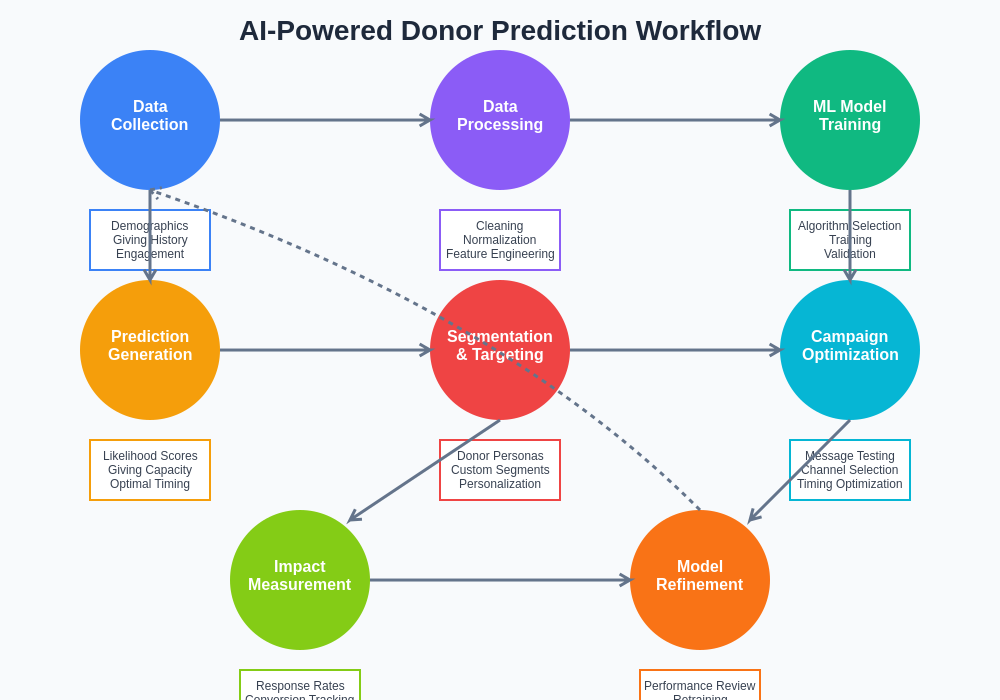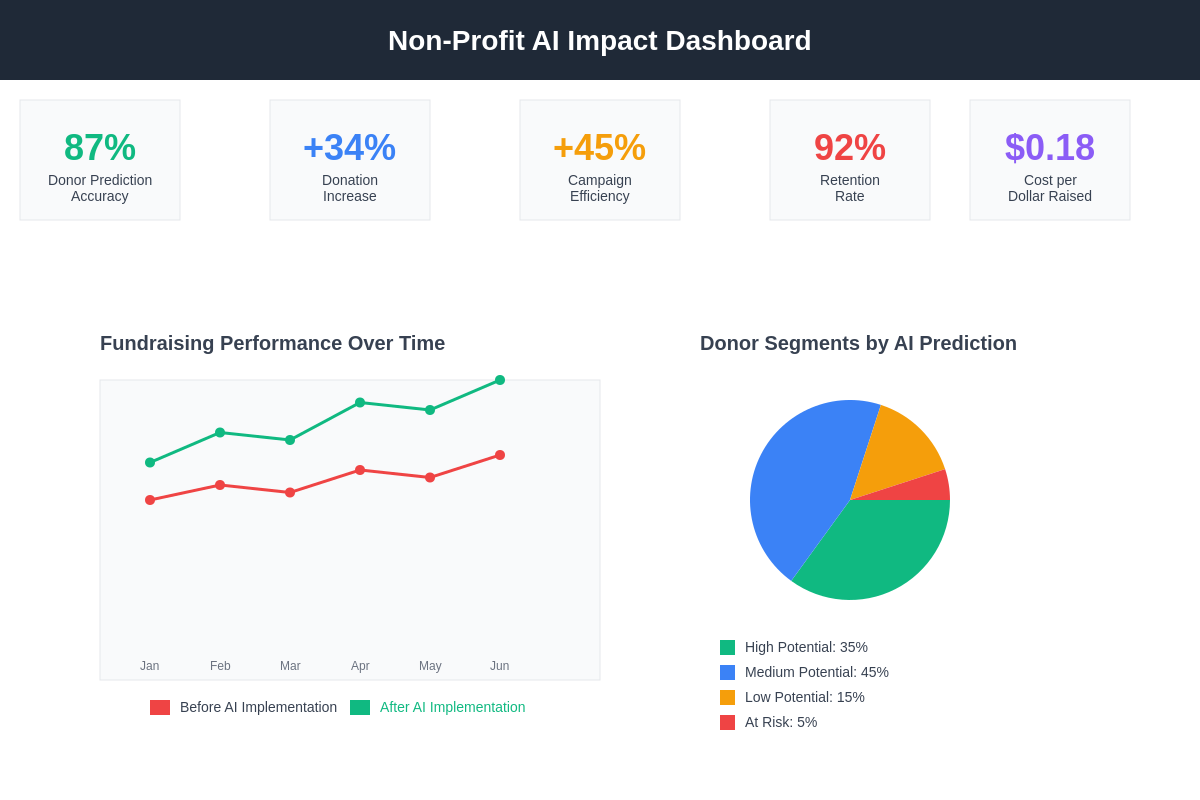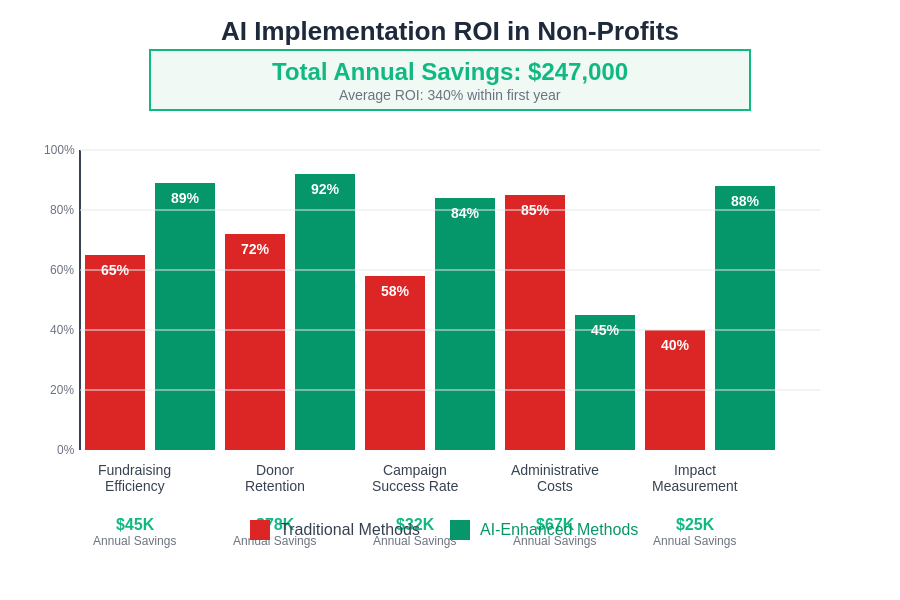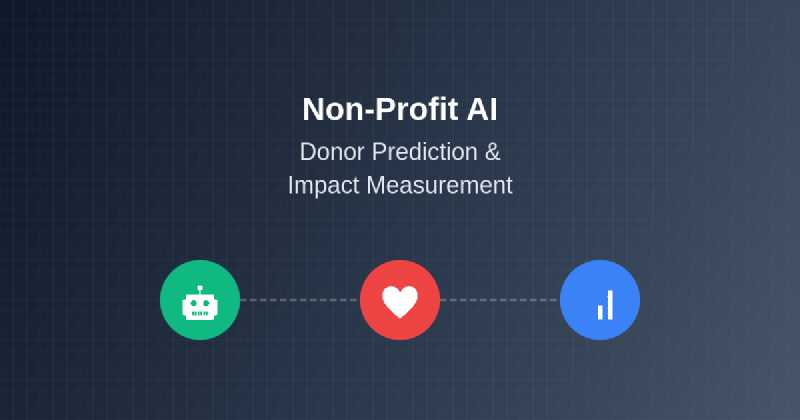The non-profit sector stands at the threshold of a technological revolution that promises to fundamentally transform how organizations engage with donors, measure their impact, and maximize their social good. Artificial intelligence has emerged as a powerful catalyst for change in the philanthropic landscape, offering unprecedented capabilities for predicting donor behavior, optimizing fundraising strategies, and delivering measurable outcomes that demonstrate tangible social impact. This technological transformation represents more than just operational efficiency; it embodies a paradigm shift toward data-driven decision-making that enables non-profit organizations to achieve their missions with greater precision, accountability, and effectiveness than ever before.
Discover the latest AI innovations transforming social impact and learn how cutting-edge technologies are being leveraged to address some of humanity’s most pressing challenges. The integration of artificial intelligence into non-profit operations represents a convergence of technological advancement and social purpose, creating opportunities for organizations to amplify their impact while building stronger, more sustainable relationships with their supporter communities.
The Evolution of Non-Profit Technology Adoption
The journey toward AI-powered non-profit operations began with the recognition that traditional fundraising methods and impact assessment techniques were insufficient for the complex challenges facing modern charitable organizations. Legacy approaches to donor engagement often relied on broad demographic assumptions and intuitive campaign strategies that lacked the precision necessary to maximize donor lifetime value and optimize resource allocation. The advent of sophisticated machine learning algorithms and predictive analytics has provided non-profit organizations with tools that were previously accessible only to large commercial enterprises, democratizing access to advanced data science capabilities that can dramatically improve operational effectiveness.
This technological evolution has been accelerated by the increasing availability of donor data, digital engagement metrics, and sophisticated analytical platforms specifically designed for the non-profit sector. Organizations that once operated primarily on institutional knowledge and traditional relationship-building approaches now have access to comprehensive data ecosystems that provide deep insights into donor preferences, giving patterns, communication effectiveness, and long-term engagement trajectories. The transformation has been particularly profound for smaller organizations that previously lacked the resources to implement sophisticated analytical capabilities.
Understanding Donor Prediction Through Machine Learning
Donor prediction represents one of the most transformative applications of artificial intelligence in the non-profit sector, enabling organizations to identify potential supporters with unprecedented accuracy and develop highly targeted engagement strategies that maximize conversion rates and donor lifetime value. Advanced machine learning models can analyze vast datasets encompassing demographic information, historical giving patterns, online behavior, social media engagement, and external economic indicators to generate sophisticated predictive scores that indicate the likelihood of donation, preferred communication channels, optimal asking amounts, and ideal timing for solicitation campaigns.
The sophistication of modern donor prediction models extends far beyond simple demographic profiling or historical giving analysis. Contemporary AI systems can identify subtle behavioral patterns and correlations that would be impossible for human analysts to detect, such as the relationship between social media engagement patterns and charitable giving propensity, the impact of economic news cycles on donation timing, or the influence of peer giving behavior on individual donation decisions. These insights enable non-profit organizations to develop highly personalized cultivation strategies that resonate with individual donor motivations and preferences.
Experience advanced AI capabilities with Claude to enhance your non-profit organization’s analytical capabilities and develop sophisticated donor engagement strategies. The integration of cutting-edge AI tools into non-profit operations enables organizations to leverage the same level of analytical sophistication that drives success in commercial sectors while maintaining focus on their core social impact missions.
Advanced Segmentation and Personalization Strategies
The application of artificial intelligence to donor segmentation has revolutionized how non-profit organizations understand and engage with their supporter communities. Traditional segmentation approaches typically relied on broad demographic categories or simple giving history classifications that provided limited insight into individual donor motivations, preferences, and engagement patterns. AI-powered segmentation systems can process multidimensional datasets to identify sophisticated donor personas that account for behavioral patterns, communication preferences, cause affinity, giving capacity, and lifecycle stage, enabling organizations to develop highly targeted engagement strategies that dramatically improve conversion rates and donor satisfaction.
Modern AI segmentation goes beyond static demographic categories to create dynamic donor profiles that evolve based on ongoing interactions, changing life circumstances, and shifting philanthropic priorities. These systems can identify emerging donor segments, predict segment migration patterns, and recommend personalized engagement strategies that adapt to changing donor preferences and behaviors. The result is a more nuanced understanding of supporter communities that enables non-profit organizations to deliver more relevant, timely, and compelling communications that strengthen donor relationships and increase long-term engagement.

The comprehensive donor prediction workflow illustrates how artificial intelligence transforms raw data into actionable insights through systematic processing, advanced modeling, and continuous optimization. This cyclical approach ensures that prediction accuracy improves over time while enabling organizations to refine their engagement strategies based on empirical results and evolving donor behaviors.
Predictive Modeling for Fundraising Optimization
The development of sophisticated predictive models for fundraising optimization represents a quantum leap forward in how non-profit organizations approach campaign planning, resource allocation, and performance measurement. These AI-driven systems can analyze historical campaign data, donor response patterns, market conditions, and external factors to predict campaign outcomes with remarkable accuracy, enabling organizations to optimize their fundraising strategies before launching expensive initiatives. Predictive modeling capabilities extend to identifying optimal campaign timing, predicting response rates for different donor segments, forecasting revenue potential, and recommending resource allocation strategies that maximize return on investment.
Advanced predictive models can simulate various campaign scenarios and recommend strategic adjustments that improve overall performance while minimizing risk and resource waste. These systems can identify which donor segments are most likely to respond to specific messaging themes, predict the optimal frequency of communication touches, determine the most effective fundraising channels for different donor types, and forecast long-term donor lifetime value based on early engagement patterns. This level of analytical sophistication enables non-profit organizations to make data-driven decisions that significantly improve fundraising effectiveness while reducing the uncertainty and risk associated with major campaign investments.
Impact Measurement Through Data Analytics
The measurement and communication of social impact has emerged as one of the most critical applications of artificial intelligence in the non-profit sector, enabling organizations to demonstrate accountability, attract funding, and continuously improve their programmatic effectiveness. Traditional impact measurement approaches often relied on simple output metrics and anecdotal evidence that provided limited insight into true social outcomes and long-term program effectiveness. AI-powered impact measurement systems can integrate diverse data sources, including program delivery metrics, beneficiary feedback, external outcome indicators, and longitudinal impact assessments, to create comprehensive impact narratives that demonstrate tangible social value and program effectiveness.
Modern impact measurement platforms can track complex outcome chains, identify causal relationships between program activities and social outcomes, and provide real-time insights into program performance that enable rapid course corrections and continuous improvement. These systems can analyze beneficiary data to identify which program elements are most effective for different population segments, predict long-term outcomes based on early intervention indicators, and optimize program delivery strategies to maximize social impact per dollar invested. The result is a level of accountability and effectiveness measurement that significantly enhances organizational credibility and funding attractiveness.

The comprehensive impact measurement dashboard demonstrates how AI-powered analytics provide real-time visibility into organizational performance across multiple dimensions. From donor prediction accuracy to fundraising efficiency metrics, these integrated dashboards enable non-profit leaders to make data-driven decisions that optimize both operational effectiveness and social impact outcomes.
Leverage Perplexity’s research capabilities to stay informed about the latest developments in non-profit technology and impact measurement methodologies. Access to comprehensive research capabilities enables non-profit leaders to stay current with best practices, emerging technologies, and innovative approaches that can enhance their organizational effectiveness and social impact.
Real-Time Performance Monitoring and Optimization
The implementation of real-time performance monitoring systems has transformed how non-profit organizations track, analyze, and optimize their operations across multiple dimensions of organizational performance. These AI-powered systems can continuously monitor fundraising activities, program delivery metrics, volunteer engagement, communications effectiveness, and financial performance to provide instant insights into organizational health and performance trends. Real-time monitoring capabilities enable non-profit leaders to identify emerging opportunities and challenges quickly, make data-driven adjustments to ongoing campaigns and programs, and maintain optimal performance across all organizational functions.
Advanced monitoring systems can automatically flag performance anomalies, identify trending patterns that require attention, and recommend specific actions to address emerging issues or capitalize on unexpected opportunities. These systems can monitor donor engagement patterns to identify supporters who may be at risk of lapsing, track program delivery metrics to ensure quality standards are maintained, analyze volunteer satisfaction and retention indicators, and provide early warning signals for potential operational challenges. This level of continuous monitoring and optimization enables non-profit organizations to maintain peak performance while rapidly adapting to changing conditions and emerging opportunities.
Donor Lifetime Value Prediction and Optimization
The development of sophisticated donor lifetime value prediction models has revolutionized how non-profit organizations approach donor cultivation, retention strategies, and resource allocation decisions. These AI-powered systems can analyze comprehensive donor datasets to predict long-term giving potential, identify optimal cultivation strategies, and recommend personalized engagement approaches that maximize donor lifetime value while strengthening supporter relationships. Donor lifetime value models account for multiple factors including giving history, engagement patterns, demographic characteristics, communication preferences, and external influences to generate accurate predictions that inform strategic decision-making across all aspects of donor relationship management.
Advanced lifetime value models can identify donors with high growth potential who may be undervalued by traditional assessment methods, predict optimal upgrade timing and amounts, recommend appropriate stewardship strategies for different donor value segments, and identify the most cost-effective acquisition channels for attracting high-value supporters. These insights enable non-profit organizations to allocate their limited resources more effectively, focusing cultivation efforts on supporters with the highest long-term potential while maintaining appropriate stewardship for all donor segments. The result is improved fundraising efficiency and stronger, more sustainable donor relationships that support long-term organizational growth and impact.
Automated Communications and Engagement Systems
The implementation of AI-powered communication and engagement systems has transformed how non-profit organizations interact with their supporters, enabling highly personalized, timely, and relevant communications that strengthen donor relationships while reducing administrative burden and operational costs. These sophisticated systems can automatically generate personalized content, optimize send timing based on individual recipient preferences, select optimal communication channels for different message types, and continuously refine messaging strategies based on engagement data and response patterns.
Modern automated engagement systems can create dynamic content that adapts to individual donor interests and preferences, automatically segment communications based on donor behavior and lifecycle stage, generate personalized impact reports that demonstrate the specific outcomes achieved through individual donor support, and maintain consistent engagement across multiple touchpoints and communication channels. These systems can also identify optimal communication frequency for different donor segments, automatically trigger appropriate follow-up sequences based on donor actions, and provide personalized cultivation pathways that guide supporters through increasingly meaningful levels of engagement with the organization and its mission.
Program Effectiveness Analysis and Optimization
The application of artificial intelligence to program effectiveness analysis has provided non-profit organizations with unprecedented capabilities for understanding which interventions produce the greatest social impact and how program delivery can be optimized to maximize outcomes for beneficiaries. Advanced analytical systems can process complex program data to identify success factors, predict program outcomes, optimize resource allocation, and recommend program modifications that improve effectiveness while reducing costs. These insights enable organizations to continuously refine their programmatic approaches based on empirical evidence rather than assumptions or traditional practices.
Program effectiveness analysis systems can identify which program elements are most critical for achieving desired outcomes, determine optimal intervention timing and intensity, predict which beneficiaries are most likely to benefit from specific programs, and recommend personalized service delivery approaches that maximize individual outcomes. These capabilities enable non-profit organizations to achieve greater impact with limited resources while demonstrating accountability and effectiveness to funders, stakeholders, and the communities they serve. The result is more effective programs that produce measurable social outcomes and sustainable positive change in the lives of beneficiaries.
Financial Forecasting and Budget Optimization
The development of AI-powered financial forecasting and budget optimization systems has provided non-profit organizations with sophisticated tools for managing their financial resources more effectively while maintaining program quality and organizational sustainability. These systems can analyze historical financial data, fundraising patterns, program costs, and external economic factors to generate accurate financial forecasts that inform strategic planning, budget allocation, and risk management decisions. Advanced forecasting models can predict revenue streams with greater accuracy, identify potential budget shortfalls before they become critical, and recommend resource allocation strategies that optimize both financial sustainability and program impact.
Financial optimization systems can simulate various budget scenarios to identify the most effective resource allocation strategies, predict the financial impact of different strategic decisions, optimize fundraising investment levels to maximize net revenue, and identify opportunities for operational efficiency improvements that reduce costs without compromising program quality. These capabilities enable non-profit leaders to make more informed financial decisions while maintaining appropriate levels of fiscal responsibility and ensuring long-term organizational sustainability in an increasingly competitive funding environment.

The return on investment analysis clearly demonstrates the substantial financial benefits that non-profit organizations achieve through AI implementation. With average annual savings exceeding $247,000 and ROI reaching 340% within the first year, AI adoption represents a strategic investment that enhances both operational efficiency and organizational sustainability while enabling greater social impact.
Volunteer Management and Engagement Optimization
The application of artificial intelligence to volunteer management has transformed how non-profit organizations recruit, engage, and retain volunteers while optimizing volunteer experiences and maximizing the social impact generated through volunteer contributions. AI-powered volunteer management systems can analyze volunteer preferences, skills, availability, and performance data to optimize volunteer placement, predict retention likelihood, personalize engagement strategies, and identify volunteers with leadership potential who might be developed for greater organizational involvement.
Advanced volunteer management platforms can automatically match volunteers with appropriate opportunities based on skills, interests, and availability, predict optimal volunteer engagement strategies that maximize satisfaction and retention, identify volunteers who may be at risk of discontinuing their involvement, and recommend recognition and development opportunities that strengthen volunteer commitment. These systems can also optimize volunteer training programs based on individual learning preferences and track volunteer impact to demonstrate the value generated through volunteer contributions. The result is more effective volunteer programs that provide meaningful experiences for volunteers while generating greater social impact for the organization and its beneficiaries.
Data Integration and Ecosystem Management
The successful implementation of AI-powered systems in non-profit organizations requires sophisticated data integration capabilities that can consolidate information from multiple sources including donor databases, program management systems, financial platforms, communication tools, and external data sources. Modern data integration platforms can automatically synchronize information across multiple systems, ensure data quality and consistency, and provide unified analytical capabilities that enable comprehensive organizational insights and strategic decision-making.
Advanced data ecosystem management includes implementing robust data governance frameworks that ensure privacy protection, regulatory compliance, and ethical data usage while maximizing the analytical value of organizational data assets. These systems can automatically identify data quality issues, suggest data enhancement opportunities, and provide comprehensive audit trails that demonstrate responsible data stewardship. The result is a unified data environment that supports sophisticated analytical capabilities while maintaining appropriate levels of security, privacy, and regulatory compliance.
Future Implications for Non-Profit Sector Evolution
The continued advancement of artificial intelligence capabilities promises to unlock even greater potential for non-profit organizations to achieve their missions while operating with increased effectiveness, accountability, and sustainability. Emerging AI technologies will likely enable even more sophisticated predictive capabilities, automated decision-making systems, and integrated operational platforms that further streamline non-profit operations while enhancing impact measurement and donor engagement capabilities.
The democratization of advanced AI tools will likely level the playing field between large and small non-profit organizations, enabling smaller organizations to access the same sophisticated analytical and operational capabilities that were previously available only to major institutions with substantial technology budgets. This evolution will require non-profit leaders to develop new competencies in data management, AI implementation, and technology-enabled service delivery while maintaining focus on their core mission and values.
The future of non-profit operations will likely involve increasingly sophisticated integration between AI-powered systems and human expertise, creating hybrid operational models that leverage the efficiency and analytical capabilities of artificial intelligence while preserving the human elements of empathy, creativity, and relationship building that remain essential for effective social impact work. This evolution represents an opportunity for non-profit organizations to achieve unprecedented levels of effectiveness and accountability while maintaining their essential human-centered approach to addressing social challenges and creating positive change in the world.
Disclaimer
This article is for informational purposes only and does not constitute professional advice regarding non-profit management, fundraising strategies, or technology implementation. The views expressed are based on current understanding of AI applications in the non-profit sector. Organizations should conduct thorough research and consider their specific circumstances, regulatory requirements, and ethical obligations when implementing AI-powered systems. The effectiveness of AI applications may vary based on organizational capacity, data quality, and implementation approach.
